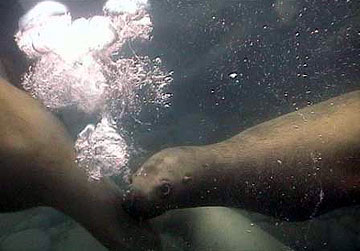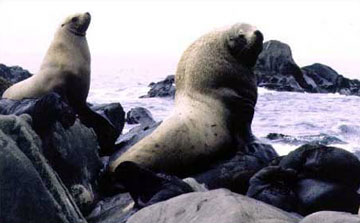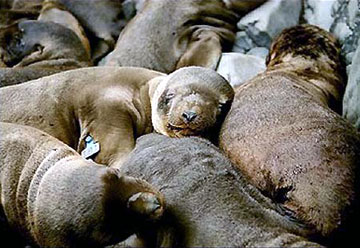 by Doug Schneider February 19, 2005
Researcher Terrie Williams believes understanding what caused the crash of Steller sea lions and sea otters in Alaska's Aleutian Islands boils down to how many calories a 5,000-pound killer whale needs to stay fat and happy. Williams said, "When you get a large predatory animal-killer whales weigh as much as 3,000 kilos-it's going to take a lot out of the environment in order to satisfy those metabolic fires." In a study published in late 2004 in the journal Ecology, Williams, a University of California marine mammal physiologist, calculated the metabolic needs of killer whales as well as the energy contained within sea lions and sea otters, two prey species whose populations in the Aleutians have plummeted over the last 30 years. Scientists continue to debate the cause of the declines. Most theories center around an ecosystem-wide shift that resulted in less food for marine mammals, seabirds and other sea life. Jim Estes is the study's co-author and a marine ecologist at the University of California. He says the study offers the best evidence yet that killer whales were at least capable of causing the crash of Steller sea lions and sea otters. Estes said, "If you know how many consumers there are and how much they have to eat, and if you know what their diets are then you can project the effects of that consumption on the things they eat. It's as simple as that." Perhaps not surprising, a killer whale needs a lot of food. Williams says an average adult female killer whale that eats marine mammals needs to consume about 164,000 calories each day. An average male will burn through 243,000 calories in a single day.
Traditionally, killer whales got those needed calories by hunting and killing large whales and whale calves. One theory holds that killer whales learned to hunt sea lions after American, Russian and European whalers decimated North Pacific whale stocks in the 19th and 20th Centuries. And when sea lion numbers crashed, killer whales went to the next item on the menu, sea otters. Williams said, "The interesting thing is that you almost can watch the history of the marine mammal declines in the Aleutian Island chain, and see killer whales eat down the food chain, from really large things that had lots of fat and protein, to progressively smaller prey items, and then finally to a sea otter." To see if a steady diet of sea lions and sea otters could actually sustain killer whales, Williams totaled up the calories found in these prey species. No animals were killed for the study. Instead, Williams used carcasses from animals found dead in the wild. Williams found that a typical male sea otter provided almost 62,000 calories when eaten whole, while a female sea otter yielded about 42,000 calories. While not bulging with energy, Williams says sea otters are not the junk food many people think. Williams said, "In actual fact when we did the experiment and we took a whole sea otter carcass and ground it up, hair and all, it actually was not as poor a nutritional item as we thought it would be. There was a high amount of protein. It's not very fatty, so as a result, killer whales would have to eat more sea otters." On the other hand, Steller sea lion pups were substantially more nutritious, offering 40 percent more calories per pound than sea otters. Killer whales are also are known to eat full-grown adult sea lions weighing as much as 1,000 pounds. But killer whales can't swallow them whole. Instead, they tear chunks of flesh and blubber from the carcass. While sea lion flesh had fewer calories than sea otter, its blubber had nearly five times more energy. So we know that marine mammals offer killer whales a nutritious meal. But could killer whales really be the cause of sea lion and sea otter declines, and if so, just how many killer whales would it take to decimate their populations?
Adding up all the numbers, Williams says if an individual killer whale fed exclusively on sea lions or sea otters, it would need to eat as many as 2,500 sea otters, or 840 sea lion pups, or 160 adult sea lions, every year, just to stay healthy. Extending these numbers across the Aleutian Islands, as few as 40 killer whales could have caused sea lion populations to crash. Even more startling: as few as five killer whales could account for the loss of tens of thousands of sea otters over the past decade, and the continued low numbers of sea lions. Williams said, "That was the amazing thing, that it would only take a pod of animals to have a pretty massive impact." While no one knows for sure just how many killer whales there are in the Aleutian Islands, recent surveys conservatively put the number at around 1,700 animals. Scientists estimate that only about 10 percent of killer whales target marine mammals exclusively. If that's true, the impact on sea lions and sea otters could be dramatic. Williams said, "It's not unreasonable to say there are 157 mammal-eating killer whales in the Aleutians, there's probably more." Williams and Estes aren't ready
to say for sure that killer whales are entirely to blame for
sea lion and sea otter declines. They say their study is mostly
a mathematical exercise aimed at understanding the potential
impact of killer whales. They also say it's unlikely that killer
whales are eating only sea lions and sea otters. If they were,
these populations would be all but extinct by now. Still, scientists
believe killer whales are playing an important role in the Aleutian
Island ecosystem, a role that needs to be better understood.
This story is courtesy of Arctic Science Journeys. ASJ is a radio service highlighting science, culture, and the environment of the circumpolar north. Produced by the Alaska Sea Grant College Program and the University of Alaska Fairbanks.
|
||||||


